sábado, septiembre 26, 2009
mi nuevo proyecto
el proyecto se llama tubes y esta hosteado (usando tubes :P) acá:
http://a-series-of-tubes.appspot.com/
los invito a probarlo, divertirse un rato, hacer preguntas del tipo "porque otro framework web en python???" etc etc.
viernes, septiembre 11, 2009
Pubsubhubbub developer's guide
naming conventions
- pshb/PSHB = pubsubhubbub
- gae/GAE = Google App Engine
- things that start with "$" are bash commands
- things that start with "!" are important notes
create directory to hold all the content of this tutorial
$ mkdir pshb
$ cd pshb
download Google App Engine SDK
$ wget http://googleappengine.googlecode.com/files/google_appengine_1.2.4.zip
$ unzip google_appengine_1.2.4.zip
download the latest version of pshb
$ svn checkout http://pubsubhubbub.googlecode.com/svn/trunk/ pubsubhubbub
start pshb
$ python2.5 google_appengine/dev_appserver.py pubsubhubbub/hub/
check that the hub started
type http://localhost:8080 on your browser, you should see something like:
Welcome to the demo PubSubHubbub reference Hub server!
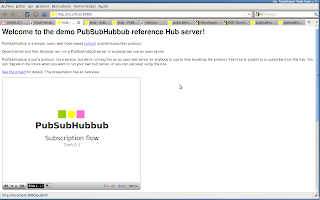
download the example
# we will need to fetch the tubes library and the example that we will be using.
$ git clone git://github.com/marianoguerra/tubes.git
# now we will start the example
$ cd tubes/ihasfriendz/
$ python main.py
* Running on http://0.0.0.0:8081/
* Restarting with reloader...
components used by the example
- werkzeug: http://werkzeug.pocoo.org
- jquery: http://jquery.com
- tubes: http://github.com/marianoguerra/tubes/tree/master
- pubsubhubbub_publish.py: from pshb
- feedformatter.py: http://code.google.com/p/feedformatter/
publish the feed to the hub
go to the following URL on your browser: http://localhost:8080/publish
on the Topic field enter: http://localhost:8081/atom/stream/_MYUSER_ and click publish
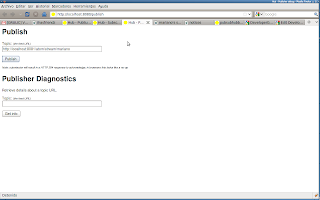
subscribing to the hub
go to the following URL on your browser: http://localhost:8080/subscribe
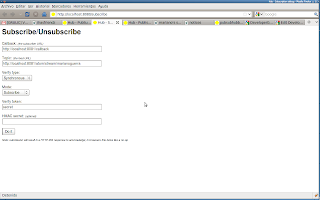
create some content
go to the following URL on your browser: http://localhost:8081/files/index.html
post some content on the form, use the user you used as MYUSER
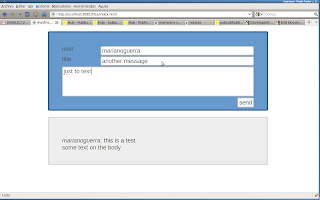
you can check that the item was posted going manually to http://localhost:8081/atom/stream/_MYUSER_, you should see an atom feed there
manually processing the tasks
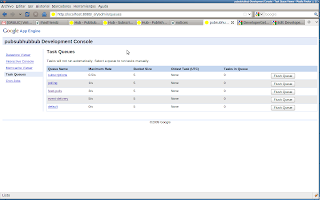
click on the feed-pulls link, there click on the run button.
when we run the feed pulls task, we tell pshb to fetch the feeds that have new content (the ones that did a post to the hub to inform that there is new content)
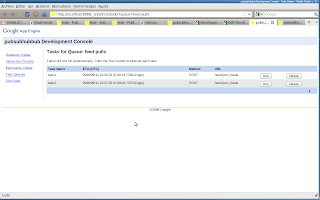
! on production hubs this tasks are done automatically
now we go again to the Task Queues page, there the event-delivery queue should have a number different than 0 (the number of messages that are pending to be sent to the subscribers), we click on the event-delivery and then we click on the run button.
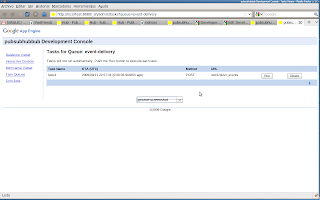
seeing it work
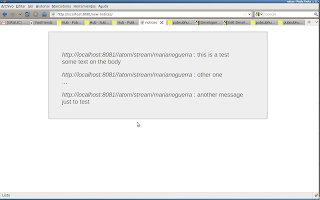
for lazy people
#!/usr/bin/env sh
# create the example directory
mkdir pshb
cd pshb
CWD=$(pwd)
EXAMPLE=$CWD/tubes/ihasfriendz
wget http://googleappengine.googlecode.com/files/google_appengine_1.2.4.zip
unzip google_appengine_1.2.4.zip
svn checkout http://pubsubhubbub.googlecode.com/svn/trunk/ pubsubhubbub
# we will need to fetch the tubes library and the example that we will be using.
git clone git://github.com/marianoguerra/tubes.git
# now we will start the example
echo "run \"cd $EXAMPLE; python main.py\" on a shell to run the example"
echo "run \"cd $PWD; python2.5 google_appengine/dev_appserver.py pubsubhubbub/hub/\" on a shell to run the hub"
jueves, septiembre 10, 2009
playing with mercurial API
[ -d fresita ] && rm -rf fresita
mkdir fresita
cd fresita
echo "test" > README.txt
my first test script:
import os
from mercurial import ui
from mercurial import commands
from mercurial import localrepo
ui_ = ui.ui()
create = 1
path = os.path.abspath('./fresita')
def repo_initialized(path):
'''return True if the repo is already initialized'''
return os.path.isdir(os.path.join(path, '.hg'))
if repo_initialized(path):
create = 0
repo = localrepo.localrepository(ui_, path, create)
repo.add(['README.txt'])
modified, added, removed, deleted, unknown, ignored, clean = repo.status()
print 'modified', modified
print 'added', added
print 'removed', removed
print 'deleted', deleted
print 'unknown', unknown
print 'ignored', ignored
print 'clean', clean
repo.commit(text="my first commit")
pretty easy :)
Seguidores
Archivo del Blog
-
►
2011
(74)
- ► septiembre (4)
-
►
2010
(111)
- ► septiembre (8)
-
►
2008
(60)
- ► septiembre (8)
-
►
2007
(64)
- ► septiembre (1)
-
►
2006
(81)
- ► septiembre (1)
